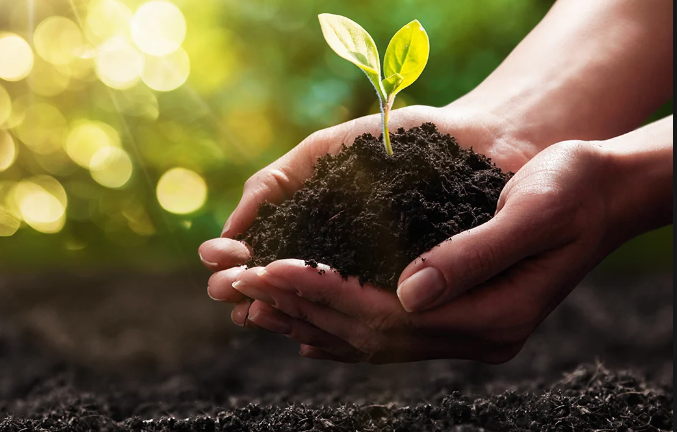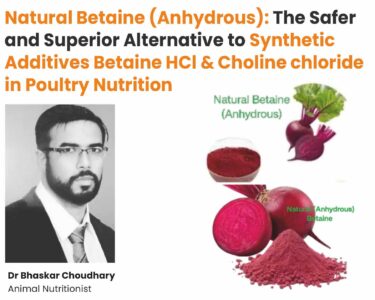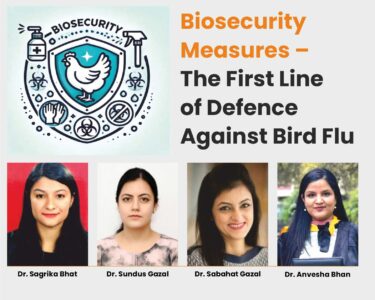
Dr.Partha P. Biswas
M.Sc.,Ph.D.,F.Z.S.,F.Z.S.I.
Former Associate Professor & H.O.D.
Dept. of Zoology, R.K.Mission V.C.College, Kolkata 700118,W.Bengal.
Senior Consultant-Poultry,Vet & Aqua inputs In West Bengal
Medivin Pharmaceuticals, Hyderabad 500070.Telengana.
Almost 51 percent of the total meat production across India was contributed by poultry during financial year 2022. The challenges of effectively controlling the waste created by the chicken industry increase as demand rises. If not properly disposed of, poultry waste is one of the potential primary pollutants. Resolving these issues requires serious attention to managing poultry waste so that the environmental impacts of such a huge volume of waste are minimized. The wastes can still be recycled into valuable items, but cost-effective technologies have not yet been found.
NATURE OF THE POULTRY WASTE
The poultry industry produces massive volumes of solid waste, including bedding materials, excreta, feed, feathers, feed scrap, mortality waste, and waste water, including faeces, urine, residual medications and pesticides, as well as disinfectants for chicken coops and garbage’s of slaughter house. Phosphorus, other minerals, and several pathogens are abundant in poultry manure. To minimize risk and gain a competitive advantage in the poultry sector, waste disposal and management must be effective.
RISK WITH POULTRY WASTE
Poultry waste contains high levels of nutrients and also electrical conductivity which can cause phytotoxicity to seedlings. Bacterial populations are mainly composed of members of the gastrointestinal tract, with few harmful bacteria. Fresh chicken dung is rich in nutrients, but it can cause problems for garden plants, if not properly treated. The high nutrient content means that the breakdown will produce enough heat for sensitive plant roots to be affected. More importantly, fresh chicken manure may contain human pathogens and parasites, including Salmonella spp.
CHALLENGES IN POULTRY LITTER MANAGEMENT
Despite the fact that poultry waste can be used in many ways, it still has some limitations, such as disposal, nutrient loss, greenhouse gas emissions during land application and long-term storage, surface water pollution, ammonia, nitrate emissions, dissolved phosphate runoff, immobilization and nutrient loss due to volatilization and microbial contamination.
The key GHGs arising from poultry manure are methane (Ch4), ammonia (NH3) and nitrous oxide (N2O), which are produced by microbes in the manure performing methanogenesis and nitrification/denitrification respectively. Since poultry litter contains manure with a high moisture content, it cannot be spread directly on plants due to its corrosive effect on foliage. Storage and direct use have also been found to have many disadvantages such as odour, fly reproduction and pathogen growth. Therefore, it is important to identify processing options that provide the best balance between reducing emissions from processing, utilizing the energy contained in the manure, and preserving nutrients as manure.
POULTRY LITTER INTO MANURE
Manure from poultry farms is a valuable organic fertilizer that should be used wisely, for example by creating a sustainable circular economy. Properly processed dried poultry manure/waste helps reduce dependence on chemical fertilizers. India produces about 38.33 million tonnes of poultry manure every year, which is enough to fertilize about 3.56 million hectares of agricultural land. Poultry waste is an excellent and inexpensive fertilizer if used correctly. Land use of seedlings returns nutrients and organic matter to the soil, which improves soil fertility and quality. In addition to macro elements N, P and K, poultry manure contains calcium, magnesium, sulfur and trace elements. Granulation uses mechanical pressure to increase the density of the material, turning it into pellets and reducing moisture. Pelleting makes them easy to ship and apply.

POULTRY LITTER INTO BIOENERGY
Incineration of poultry litter has received much attention as a method of generating heat and electricity in large, centralized facilities. Several US states have tried to generate electricity from renewable green sources for thermal conversion of biomass. Methane (biogas) is used to run the turbines that produce electricity. Minnesota, for example, produces more than two million tons of turkey and chicken waste – ‘poultry power’. Now, some Minnesota turkey farmers are working with a British company that builds a manure incinerator in central Minnesota in 2007.The plant burns nearly half a million tons of poultry waste each year and produces 50 megawatts of electricity, enough to power 40,000 households. Similarly, a power plant based on poultry waste has been proposed in Western Australia. Using this substrate for biogas production can eliminate the problems associated with its disposal and create another abundant source of sustainable energy. About 1 m3 of biogas can produce about 2 kW of electricity and India can produce 270 MW of electricity per year from poultry waste.
POULTRY LITTER TO BIOCHAR PRODUCTION
Biochar is a charcoal-like substance that’s made by burning organic material from agricultural, forestry poultry & dairy wastes (also called biomass) in a controlled process called pyrolysis. Due to its high lignocellulosic content and low humidity, ample amount of poultry litter can be readily converted to biochar. Using biochar, a solid formed from carbonized biomass, on land can enhance soil properties and lower greenhouse gas emissions brought on by biomass degradation. In subtropical climates, poultry waste biochar can reduce nitrogen mineralization rates, resulting in higher nitrogen usage efficiency and crop yield. Poultry litter biochar is made from fresh poultry litter by pyrolyzing (technique used to break chemical bonds of molecules by the use of thermal energy only) it for 10 min at 300°C in a muffle furnace with low oxygen.

Fig.2: Circular bioeconomy concept includes the use of chicken litter to create a biogas plant and then recycling the energy for lighting and keeping the poultry house warm.

Fig.3: Poultry litter (PL) utilization to produce nutrients enriched Biochar
FEATHER WASTE TO PROTEIN & FEW MORE PRODUCTS
Bird feathers are mainly composed of keratin, which is an insoluble, fibrous, recalcitrant protein, and it accounts for 85% to 99% of the total dried feather weight. Microbial keratinases exhibit a significant role in converting keratin biowastes into exceedingly valuable protein supplements. This study reports a novel, highly stable keratinase from Bacillus pacificus RSA27 for the production of pure peptides rich in essential amino acids from chicken feathers. It has also been found that the feather-lysate produced by Bacillus licheniformis PWD-1 has nutritional property for feed similar to soybean meal. Feather meal production is also done by hydrothermal process where feathers are digested under high pressure at high temperature. But such treatment leads to destruction of essential amino acids like methionine, lysine, tyrosine, tryptophan. A slow-release nitrogen fertilizer has been developed from poultry feathers. Some new techniques are production of biodiesel from feather meal, non-woven textile materials prepared from chicken feathers, production of biodegradable plastics etc.
POULTRY BY-PRODUCT MEAL (BPM)
By-Product of Poultry Meal is the protein that remains after the fat and moisture from chicken source material have been taken during the regular rendering process. Product of Poultry Meal is a light brown powder that is utilised as a protein source in animal feed. It is one of several elements used by a nutritionist to create a full meal. It is composed of pulverised rendering sections of killed chicken carcasses, such as heads, feet, developing eggs, and intestines, excluding feathers save in trace amounts that are unavoidably present in acceptable manufacturing practises. The process is vacuum-operated, with the first stage running at around 120° F and the second stage operating at around 276° F. The product is subjected to temperatures as high as 310° F for 30 to 40 minutes while it passes through the evaporators. The completed product contains no chemical or other additives. An independent lab tests the completed product for salmonella and coliforms on a regular basis.
POULTRY OFFALS
Poultry offals are solid by-products. Solid wastes of poultry slaughterhouse or poultry processing plant includes parts and/or whole poultry carcass, undeveloped eggs. Offal consists of 5.3% of total Kjeldahl nitrogen (sum of organic nitrogen, ammonia NH3 and ammonium NH4+ ), 32% proteins, 54% lipids and 0.6 to 0.9 % methane production potential. According to one study, significantly higher body weight, as well as, better feed conversion ratios were found in poults fed diets with 25% poultry waste carcass meal crude protein replacement, compared with diets containing only fishmeal as a protein source. Broiler’s litter may be used as supplement of high-fiber diet with fungal enzyme mixture (cellulase, amylase and pectinase).
POULTRY LITTER TO BSFL AS PROTEIN SOURCE
Many insects are able to feed on organic waste efficiently and convert manure into biomass for insects at low cost. Black Soldier Fly Larvae (BSFL) is a biomass growing material that can be used as poultry litter substrate. This insect larvae is edible due to its ideal amino acid composition and can be used as animal feed protein source (Biswas, 2020).

Fig.4 : Poultry By-products as a potential source of protein in animal feed
It is also a more sustainable and eco-friendly way of disposing of poultry rubbish. The treatment efficiency of BSFL depends on the companion bacteria. Not only does it promote BSFL growth, but it also promotes development and manure reduction. It also increases the protein and fat accumulation of larvae (Mazza et al., 2020).

Fig.5 : Black Soldier Fly Larvae (BSFL) are used as a high quality food source for chicken.
POULTRY LITTER TO BROILER DIET
When three different types of poultry litter, Broiler’s (BL), Layer’s (LL), and Grower’s (GL), are fermented by a mixed starter microbial culture of Aspergillus niger, Leuconostoc spp., and Candida utilis, the crude protein, nitrogen free extract, calcium, phosphorus, biomass, and amino acid content increase (Onilude, 1999 ). It may be fed to chicks, and studies show a correlation between enzyme supplementation and body weight, feed efficiency, and edible meat.
CONCLUSION
Poultry is the fastest growing business in our country. In terms of employment and food production, the poultry industry contributes significantly to nation-building. It is currently encountering difficulties in regulating poultry litter. Even if poultry waste management companies are doing a decent job, the vast volume of trash created currently appears to make this a herculian task.
REFERENCES
Biswas Partha P.( 2020) : Concept of a ‘ fish meal uquivalent ‘ -could it be insect meal ? Aquaculture Asia Pacific.Sept-Oct.vol.16(6)pp.58-60.
Mazza Lorenzo et al.( 2020 ) : Management of chicken manure using black soldier fly (Diptera: Stratiomyidae) larvae assisted by companion bacteria. Waste Management vol 102 : Feb. pp.312-318.
A.A. Onilude ( 1999 ) : Fermented poultry litter and fungal enzyme supplementation of high-fibre broiler diets: Growth responses, carcass characteristics and blood lipids of fed chicks. Food/Nahrung, 43 pp. 54-60.






